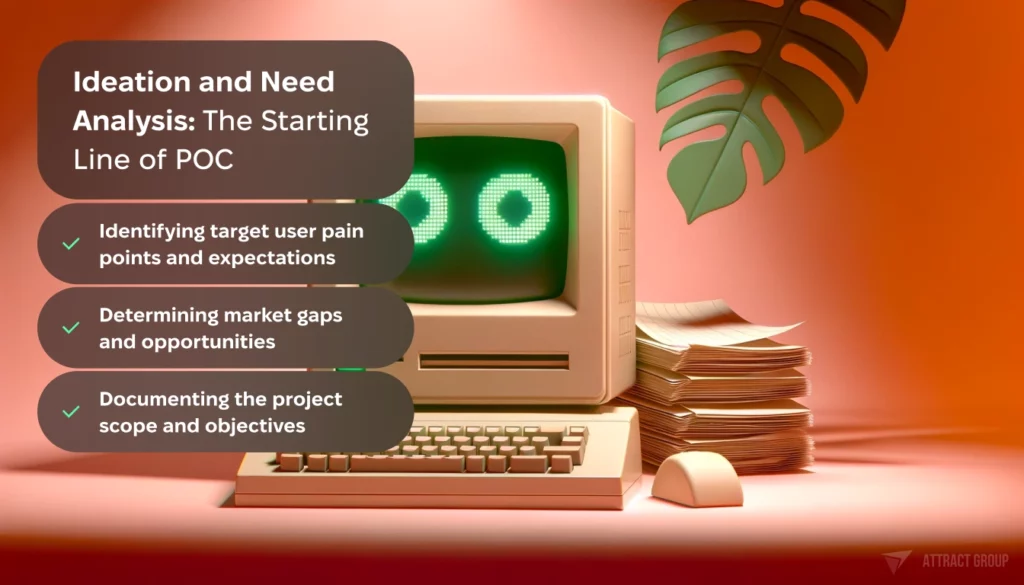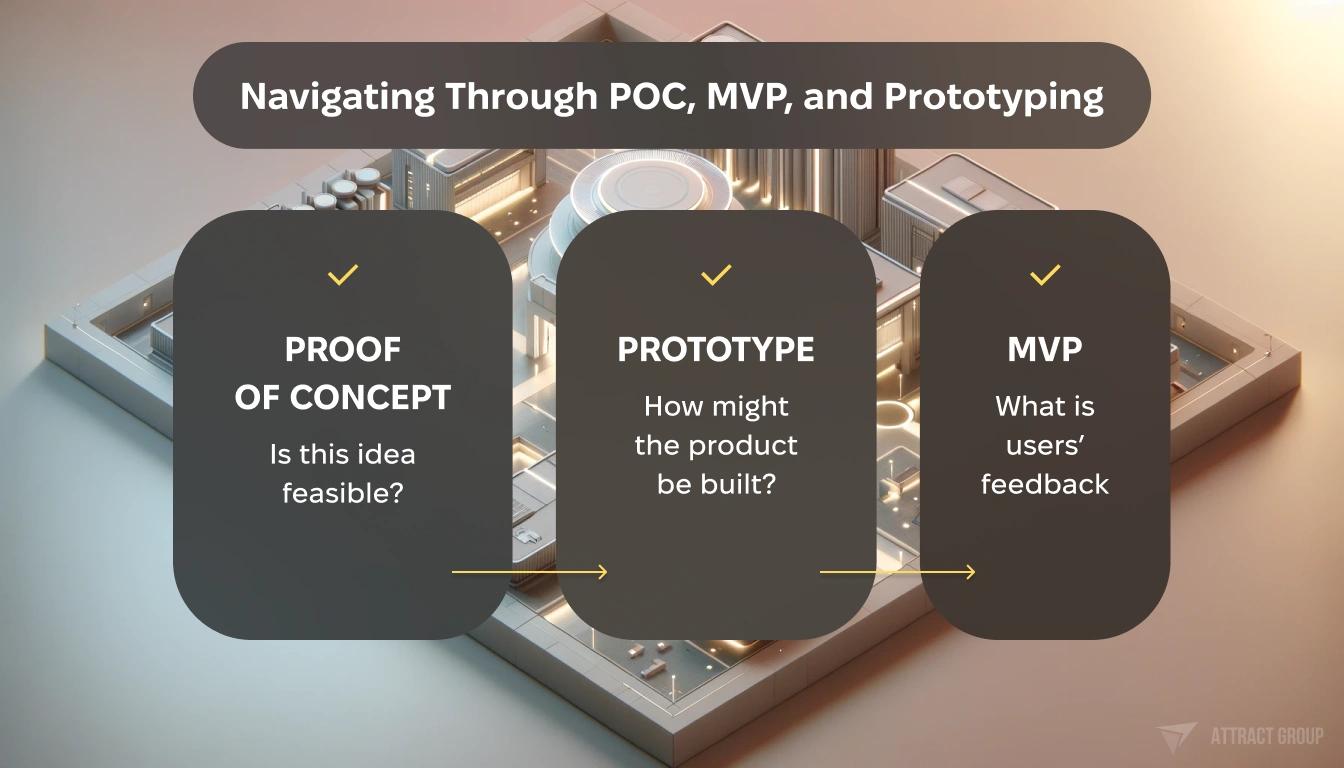Understanding POC in Software Development
 3 February 2024
3 February 2024? Listen to the Summary of this article in Audio
The landscape of software development is continuously evolving, underscoring the need for methodologies that validate the efficacy and applicability of new software before full-scale implementation. Among these methodologies, the Proof of Concept stands out as a cornerstone in the early stages of the product development lifecycle. But what is it in software development?
In essence, it serves as a foundational test to determine whether a software idea can be transformed into a functioning product. It is a crucial phase where assumptions are scrutinized, and concepts are put to the test in real-world scenarios. The aim is not just to exhibit technical feasibility, but also to ensure that the proposed solution effectively addresses the actual problems and demands of the target market.
It’s about asking the right questions early on: Does this idea fill a gap in the market? Will it resonate with its intended users? Can it be developed within reasonable cost and time constraints? By answering these questions, it becomes the litmus test determining whether an idea holds the potential to succeed or requires further redefinition.
Key Takeaways
- A Proof of Concept is essential in assessing whether a software concept can be actualized.
- Validates the software idea against market requirements and user needs.
- Provides early insight into the feasibility of the proposed software, crucial for risk mitigation.
- Establishes a pragmatic approach to software development, avoiding costly over-investments.
- Acts as a critical communication tool among stakeholders, investors, and developers.
- Ensures the software not only meets technical criteria but also adds real value.
- Sets the stage for a focused and informed transition into subsequent development phases.
The Significance of Proof of Concept in Preventing Startup Failures
As engines of innovation, startups often encounter challenges on their journey to offer new value to consumers. In this environment, implementing it becomes a step in ensuring the viability of products. Given that it plays a role in mitigating risks and guiding startups, its importance cannot be overstated.

The Alarming Statistics: Startup Success and the Role of POC
Harvard Business Review has highlighted concerning data, revealing that over two-thirds of startups fall short of returning value to their investors. This statistic brings to light the harsh realities new companies must navigate. The inception of a Proof of Concept strategy, however, can be transformative, fortifying the startup’s approach to product development and disproportionately contributing to startup success. By validating the feasibility of a software concept early on, PoC serves as a key component in a startup’s arsenal, laying down the groundwork for future scalability and market penetration.
Risks of Skipping the POC Phase in Software Development
Rapid acceleration is a goal among startups for first-mover advantage. However, omitting this phase can introduce pitfalls, misallocated resources and a product out of step with demands. The absence precipitates risk escalation, often unfortunate expenditure for ventures poorly tailored to the landscape.
The Strategic Value of POC to Investors and Developers
For developers and financial backers, the PoC translates to more than just a developmental checkpoint; it symbolizes a commitment to due diligence and strategic foresight. This phase of POC development embodies the meticulousness required to not only conceive but also to critically assess ideas in the context of real-world applicability and user adoption. It fortifies the developer’s blueprint with a consumer-centric approach while enhancing investor confidence in the startup’s capacity for prudent decision-making and risk management. Engaging stakeholders in the PoC process harmonizes their perspectives, aligning their collective vision towards a unified, compelling goal that transcends mere profitability; it positions the startup for enduring success.
Partner with our experts to develop a comprehensive POC, analyzing feasibility and aligning your product vision with market needs.
POC Defining
When delving into what is proof of concept in software development, it’s crucial to recognize it as a verification methodology designed to confirm that a system, application, or product can function in a real-world environment. This proof of concept development phase is fundamental, acting as a pivotal checkpoint that helps to establish whether the initial idea can meet the evolving needs of the market and its users. A well-articulated PoC validates the feasibility of the idea, offering a convincing argument for its potential return on investment, without the immediate need for coding or detailed design.
The importance of a PoC extends throughout the stages of conception to realization, where each functional and non-functional aspect of the proposed solution is methodically scrutinized. Below is a breakdown of various considerations addressed in a PoC:
- Technical Validation: Ensures the software can be built with current technologies.
- Operational Assessment: Examines how the software will perform under real conditions.
- Market Analysis: Determines if there’s a genuine need or desire for the product in the intended market.
- Financial Justification: Gauges whether the concept presents a worthwhile investment.
By exploring these facets, those involved in proof of concept development gain insights that greatly contribute to the decision-making process, and pave the way for a more streamlined and effective build phase—should the project go forward. Notably, PoC is not to be mistaken for prototypes or minimum viable products (MVPs), as it precedes these stages and serves a distinct purpose in the initial validation of software ideas.
Conclusively, a PoC is a critical underpinning in software development, ensuring that ideas, in their infancy, are subject to rigor and scrutiny akin to feasibility studies across various industries. This due diligence is a protective measure as much as it is a proactive step and is an emblematic practice within successful software development companies. The subsequent investment in further development stages is then backed by a solid foundation of evidence that supports the software concept’s potential success.
Primary Functions and Advantages of POC in Software Projects
Proof of Concept has become an essential strategy in software development, manifesting as a pre-cursor to full-fledged development efforts. It plays a pivotal role in defining the core functionalities and confirming the all-important question of feasibility — essentially serving as a critical filter to ensure that the software product is not only possible but poised for success within its intended market.

Technical Feasibility: The Core of POC Development
At the heart of POC is the matter of assessing technical feasibility. Engaging in a PoC allows software developers and project managers to validate whether the proposed software’s capabilities align with current technological advancements and constraints. It addresses the foundational question: Can this software be developed with the technology and resources available?
Market Need Assessment through Effective Proof of Concept Execution
Understanding and effectively targeting market requirements is another cornerstone of POC’s utility. A robust PoC process involves market need assessment to ensure that the software not only functions technically but also provides solutions to real problems faced by potential users. By proving its relevance to actual market demands, the PoC underscores the product’s potential for user adoption and commercial success.
Cost Management and Rational Budgeting Aided by POC
Financial prudence is yet another benefit offered by PoC, particularly through intelligent cost management. Early-stage budget considerations infuse the development process with rational thinking, guiding startups and enterprises alike to allocate funds effectively and avoid overcommitting on resources for projects that may not yield the expected return on investment.
Building on these benefits, a Proof of Concept not only serves as a confidence booster for investors but also as a guiding light for developers. As a consequence, products stemming from a well-conceived Proof of Concept are more likely to be in lockstep with user needs and technological capacity, steering projects towards successful market introductions and sustainable growth. It is this blend of practical validation and strategic forecasting that embodies the essence and importance of Proof of Concept in the complex tapestry of software development.
Let our team provide end-to-end guidance on executing a rock-solid POC tailored to your software idea and development goals.
What is POC in Software Development and Why It’s a Critical Initial Step
In the vibrant realm of software innovation, the term Proof of Concept frequently arises, posing the crucial question: what is a proof of concept in software development? In its most fundamental sense, a PoC is a strategic evaluation used to determine the technical viability and market potential of a software idea before proceeding into full development. This critical step is not simply about showcasing an idea but providing concrete evidence that the concept is capable of fulfilling a need within the market and that it can be executed with the current technology and resources at hand.
The establishment of a PoC is often the first tangible step in a software project and serves multiple pivotal roles:
- Demonstrates the project’s feasibility and operational validity in a real-world setting.
- Documents and conveys the project’s objectives, requirements, and envisioned procedures.
- Acts as a critical checkpoint for stakeholders to review the project’s direction and foundation.
- Facilitates the decision-making process, enabling clear direction for the project’s future.
- Bolsters investor confidence by illustrating the concept’s cogency and potential return on investment.
A comprehensive PoC encompasses a variety of aspects that contribute to the project’s perceived success before entering the resource-intensive phases of development. It offers a blueprint of the project that addresses essential considerations such as user benefits, technical limitations, innovative angles, and competitive advantages. Here is an example of what diligent documentation within a PoC may encompass:
| Aspect | Description |
|---|---|
| Technical Feasibility | Evaluates whether the project can be built using available technologies and if potential technical roadblocks can be overcome. |
| Market Analysis | Assesses market needs and validates whether the software offers a solution to real user problems, thus ensuring market relevance. |
| Budget Forecasting | Projects the financial requirements and provides a cost-benefit analysis to determine the project’s alignment with budget constraints. |
| Stakeholder Assurance | Presents a well-founded argument for the project based on solid research and analysis, hence gaining stakeholder approval. |
| Risk Evaluation | Identifies possible risks and outlines mitigation strategies, contributing to more precise project planning. |
By engaging in proof of concept development, businesses are able to effectively anticipate hurdles, optimize resources, and align expectations — forging a path towards a successful software product that resonates with both users and investors alike. Ultimately, a PoC in software development acts as an indispensable compass, guiding the initiative from mere ideation to a well-founded concept ready for the subsequent voyage into the marketplace.
Methodical Approach: Key Steps in Crafting a POC
The journey to create a successful proof of concept in software development begins with a series of methodical steps that anchor the project’s early vision in reality. This involves detailed planning, creative problem-solving, and constructive feedback mechanisms that collectively aim to mitigate risk and forge a path toward a viable product.
Ideation and Need Analysis: The Starting Line of POC
To understand how to create proof of concept in software development, one must start at the ideation phase. This is where real-life problems are identified, and initial assumptions are scrutinized. The need analysis is the playground where future solutions are benchmarked against the market and end-user demands. It forms the grounding layer where the problem space is defined, ensuring the PoC aligns with actual needs rather than assumed wants.
- Identifying target user pain points and expectations
- Determining market gaps and opportunities
- Documenting the project scope and objectives

Conceptualizing Solutions: The Creative Heart of POC
At this stage of app development proof of concept, creativity converges with strategy. Brainstorming sessions yield a host of potential solutions, each to be weighed against factors such as technical feasibility, budget constraints, and timeline. Here, different scenarios are mapped, and their viability assessed. Diverse ideas are encouraged and documented, setting the stage for the iterative process that follows.
User Feedback and Prototyping: Testing the Waters Before Full-scale Development
Prototyping is integral to the PoC stages, as it translates conceptual frameworks into interactive experiences. User feedback becomes paramount — potential users test these early models and provide insights that can radically shape the development trajectory. This iterative process of prototyping and reviewing is the crux of user-centered design, leading to a product that resonates deeply with its intended audience.
- Developing initial prototypes based on conceptualized solutions
- Conducting user tests to validate assumptions and usability
- Iterating based on feedback to refine project direction
By methodically navigating each of these stages, teams are better positioned to turn proof of concept endeavors into successful software development projects. A carefully crafted PoC not only sparks investor interest but also ensures the team advances with a solid blueprint, paving the way for future iterations and further development milestones.
Our developers can provide dedicated support through every phase of crafting a robust, insightful POC for your software concept.
From Theory to Reality: How POC Translates into App Development
The trajectory from a nascent software idea to a fully functional application is intricate and layered with critical evaluations. One such evaluation, central to the POC meaning in software development, is the Proof of Concept. It is more than just a theoretical exercise; it is a practical exploration that brings an abstract idea into the realm of the possible. As we dive deep into POC app development, we unravel how this early-stage assessment shapes the future of software projects.
The Iterative Nature of POC in Shaping Software Features
POC is inherently iterative, allowing ideas to undergo repeated refinement. Through cycles of feedback, the initial concept gradually evolves, incorporating input from various stakeholders. This iterative process ensures not only that the concept is viable but also that it is attuned to the nuanced requirements of its intended users. By fostering regular input and analysis, the Proof of Concept becomes a dynamic foundation for achieving resonance with market demands and technological capabilities.
POC as a Launchpad for User-Centric Design and Functionality
Understanding the users is pivotal in shaping a successful application. Herein lies the significance of Proof of Concept in software development — it serves as the launchpad for designs and functional specifications that prioritize user needs above all else. A focused POC phase assesses how a conceptual solution fits into the user’s life, what pain points it alleviates, and how it enhances the user experience. As such, POC app development becomes a careful calibration of a product’s features to the preferences and expectations of its end-users, ensuring that upon release, the software is not just functional but truly user-centric.

Case Studies: Real-World Examples of Successful POC in Software Development
Exploring real-world instances where a proof of concept in software development has led to impressive outcomes reinforces the importance of this initial stage in the innovation pipeline. These examples not only validate the feasibility of groundbreaking ideas but also demonstrate the practical application of technology in solving complex issues. Here are notable examples that illustrate the strength of a well-executed PoC in turning software development concepts into tangible, operational success stories.
- Walmart’s Blockchain Initiative for Supply Chain Management: The retail giant collaborated with IBM to utilize blockchain technology in tracking the provenance of food products. They conducted a PoC with dual focus: tracking mangos in the USA and pork in China. Despite skepticism, this proof of concept software development example was successful, drastically reducing the time needed to trace the origin of food items from days to mere seconds. This showcases the PoC’s ability to confirm a concept’s technical feasibility before full-scale adoption.
- Naontek’s Digital Platform for Healthcare Professionals: Naontek, a startup based in Germany, recognized the unmet needs within the healthcare sector — mainly the lack of a centralized educational platform for medical professionals. Their PoC paved the way for developing a platform that addressed these needs effectively, exemplifying how technology can forge connections within professional communities and fill critical industry gaps.
“The proof of concept is about validating our vision for the product and its necessity in the market. It allows us to test foundational ideas without the risk and expense of full production, offering a way to demonstrate potential success and secure stakeholder buy-in.”
These proof of concept in software development examples not only succeeded in verifying the projects’ technological validity but also in providing key insights into market needs, development requirements, and potential challenges. This level of early-stage assessment and validation is crucial for software development projects to transition successfully from theoretical models to market-ready solutions.
Comparing POC with MVP and Prototype in the Development Lifecycle
When navigating the complex waters of software development, understanding the nuances of a Proof of Concept , a Minimum Viable Product (MVP), and a prototype becomes essential for success. While interconnected, each serves a unique purpose and plays a critical role at different stages of product evolution. As an entrepreneur or a developer, knowing the differences between PoC vs MVP, PoC vs prototype, and choosing the right development approach can set the course for a product’s success or failure.
The Distinct Purposes of POC, MVP, and Prototype
A PoC is the preliminary stage in the validation of a concept. It asks the fundamental question of whether the idea can be implemented technically. Following a successful PoC, the next phase often involves developing an MVP, focusing on the product’s marketability with just enough features to attract early adopters and validate if the concept resonates with customers. Transitioning further, a prototype provides a tangible experience for users, emphasizing the usability and design aspects of the product, often used for collecting detailed user feedback.
Navigating Through POC, MVP, and Prototyping: Choosing the Right Approach
The transition from PoC to MVP to a prototype is critical as it pushes an abstract idea into the realm of tangible products. This progression relies on careful evaluation, iteration, and continuous refinement. Each stage aggregates more complexity and user insight, which when executed correctly, helps in optimizing both the development process and the final product. The choice among PoC vs MVP, PoC vs prototype is not about selecting one over the others. Instead, it is about recognizing where you are in the development cycle and what you need to move forward.

Below is a comparative table that illustrates the core focus, role, and typical outcome for each of these foundational approaches:
| Approach | Core Focus | Role in Development | Typical Outcome |
|---|---|---|---|
| Proof of Concept (PoC) | Technical feasibility and idea validation | Verifies that the concept is technically possible and internally coherent | A report or presentation confirming the idea’s validity, often used to gain initial stakeholder support |
| Minimum Viable Product (MVP) | Marketability and basic functionality | Tests the product’s core value proposition in the real market to garner early customer feedback | A functional product with enough features to satisfy early customers and provide feedback loops for future development |
| Prototype | User experience and design | Aids in exploring the look and feel of the product; allows for usability testing and design improvements | An interactive model closer to the end product that provides stakeholders a better understanding of the user experience |
Selecting the right approach at each phase is critical. Entrepreneurs and teams must be discerning when choosing which methodology — whether it’s a PoC, an MVP, or developing a prototype — will provide the most value and best position the product for success throughout its lifecycle.
The Financial and Operational Impact of POC on Startups
Embarking on the development of new software without a clear roadmap can lead startups to detours fraught with financial risk and operational inefficiency. In this context, a Proof of Concept — the full form in software development being a demonstrated evidence of a project’s feasibility — becomes a pivotal strategy, either saving the day or sounding early alarms. Let’s consider the vital functions a well-implemented POC serves for startups at these crossroads.
Investment Security: How POC Protects Stakeholder Interests
Investment in emerging technology is inherently risky. Startups typically have limited capital and must use it judiciously to build products that attract further investment and customer interest. The POC development process allows them to validate their ideas against established criteria, providing a layer of protection against the financial pitfalls of chasing unfeasible projects. For investors, developers, and founders alike, it signifies an assured step in a direction that’s been vetted for viability and market demand.
Forecasting Success: POC as a Predictive Tool in Software Development
Forecasting the potential success of a software product can save startups from future obstacles. It embodies this foresight, enabling developers and stakeholders to anticipate challenges, devise solutions, and streamline the development process for a smoother run. Through its iterative stages, it turns vision into an actionable plan, aligning expectations and investment with project capabilities and market realities.
It’s not magic but method that underpins the approach in software development. Startups gain a tangible grasp on their aspirations, understanding early if their project warrants the time and capital investments. As a compass for navigating the journey, it ensures resources are directed toward proposals with the highest probability of meeting market needs, hence securing the financial backbone of the enterprise.
Let’s consider an example. Walmart’s collaboration with IBM to implement blockchain technology in supply chain management involved rigorous phases before implementation. Their success has become a testament to the power of it in mitigating risk and enhancing operational accuracy. Similarly, in the digital healthcare arena, startups have used it as a stepping stone to address complex challenges, thereby situating themselves firmly on the path of innovation and utility.
We see, therefore, that the process is not just a step in the lifecycle, but a keystone practice that undergirds the entire edifice on which startups construct their hopes and dreams. With it, financial prudence pairs with operational foresight to chart a course that’s prudent, practical, and poised for success.
Conclusion
At its essence, what is it but the process of transforming ideas into reality? It in software development is not a mere formality — it’s a strategic crucible in which the mettle of every new idea is tested. By undertaking development, startups potentiate their ideas with hard evidence of feasibility, functionality, and viability. This phase is crucial; it’s where prowess intertwines with foresight, and the alchemy of innovation occurs. When it is prioritized, it marks the beginning of a journey toward creating something that resonates not only with the pulse but with the very people it seeks to serve.

Indeed, the value of a solid one extends well beyond its role as a technical gatekeeper. It’s the stage at which the rhythm of collaboration between investors, developers, and users finds its harmony, setting a foundational beat for the product’s lifecycle. The insights derived are instrumental in providing startups with the clarity needed to steer their products through the competitive currents of the tech ecosystem. To ask, ‘what is development,’ is to understand it as the bedrock that anchors the process in practicality and sensitivity.
The translation of this intrinsic phase into operational terms is where ideas gain legitimacy. Concluding our exploration, it’s evident that development POC ushers in a proactive stance for startups — a stance that’s vigilant, prepared, and attuned to the shifting sands of user needs and technological advancement. As such, embracing is more than adopting a step; it is endorsing a philosophy of mindful development that’s cognizant of the intricate dance between innovation and practicality.
Start with a rock-solid Proof of Concept. Our experts are ready to guide you through the process.
FAQ
What is POC in Software Development?
POC in software development stands for Proof of Concept. It is a method used to verify whether a system, application, or product can operate successfully in real-world scenarios. The POC process validates the technical feasibility of the concept and helps to determine if the proposed solution addresses market needs effectively before going into full-scale development.
Why is Proof of Concept significant in preventing startup failures?
Proof of Concept is vital in preventing startup failures as it tests the viability of ideas before significant resources are invested. It allows startups to explore the feasibility of their product in terms of both technical capability and market demand, which can significantly improve success rates and reduce the high risk of startup failure.
What are the risks of skipping the POC phase in software development?
Skipping the POC phase can lead to investing in a product that may not be technically feasible or does not meet market needs, which can result in financial losses and wasted resources. It also increases the likelihood of project failure due to unforeseen technical or market-related issues that could have been identified during the POC phase.
How does POC provide strategic value to investors and developers?
POC offers strategic value by allowing investors and developers to validate the idea’s feasibility, potential market success, and technical requirements. It provides a structured way to assess risks, plan budgets, and gain investor confidence, ensuring that the project aligns with business objectives and market expectations.
What are the primary functions and advantages of POC in software projects?
The primary functions of a POC in software projects include assessing the technical feasibility of a concept, understanding market needs, and managing costs. Advantages include early identification of potential project bottlenecks, alignment of product vision with real-user needs, and more informed decision-making regarding budgeting and investments.
What are the key steps in crafting a POC in software development?
Key steps in crafting a POC include defining the problem the software aims to solve, ideating potential solutions, and engaging in creative brainstorming. This is followed by developing prototypes to test these solutions and collecting feedback from potential users to refine the product roadmap.
How does POC translate into app development?
POC translates into app development by using the feedback and insights gained during the POC phase to shape the software’s features and functionality. Through an iterative process of development and testing, the POC helps to evolve a concept into a user-centric design that meets real-world requirements.
Could you provide examples of successful POC in software development?
Yes, Walmart’s implementation of blockchain technology to enhance supply chain traceability is a successful example of POC in software development. Another example is Naontek’s digital platform aimed at connecting the healthcare sector in Germany, which showcased the feasibility of technology solutions in addressing industry challenges.
What are the distinct purposes of POC, MVP, and Prototype in the development lifecycle?
The distinct purposes of these development stages are as follows: POC tests the idea’s technical feasibility; MVP (Minimum Viable Product) assesses the product’s marketability with the most basic functionality to attract early adopters; and prototypes provide an interactive model to evaluate usability and design elements.
How does POC protect stakeholder interests and forecast success in software development?
POC protects stakeholder interests by validating the viability of the product idea before significant investments are made, thus saving potential costs associated with developing an unviable product. As a predictive tool, POC helps startups to plan development steps strategically, align resources efficiently, and outline a clear vision with documented evidence, increasing the likelihood of project success.










